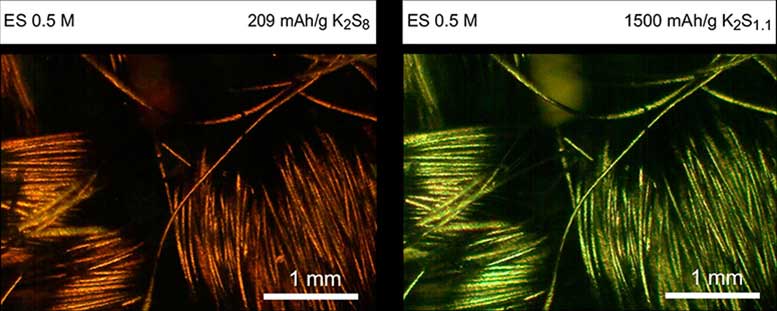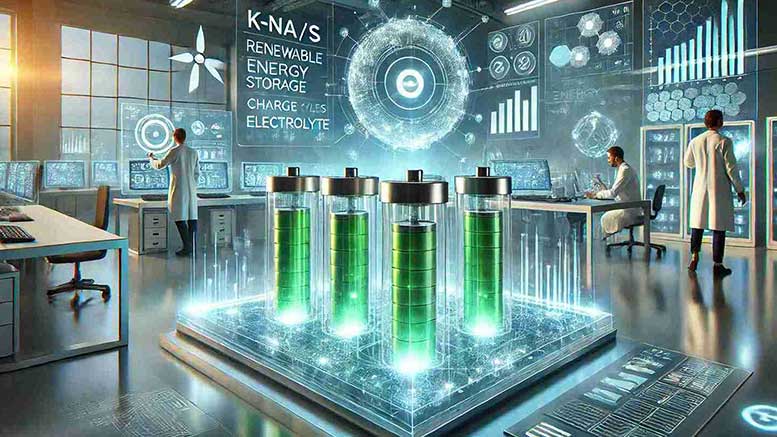Revolutionizing Energy Storage: Discover the Breakthrough Electrolyte Boosting K-Na-S Batteries!
New Electrolyte Boosts K-Na/S Batteries
New Electrolyte Boosts K-Na/S Batteries for Better Renewable Energy Storage
Columbia engineers have unveiled a groundbreaking “fuel” for batteries—an electrolyte that boasts greater longevity while also being more cost-effective to produce.
Renewable energy sources, such as wind and solar, are pivotal to our planet’s future but grapple with a significant obstacle: they fail to consistently generate power during peak demand. Fully harnessing their capabilities demands efficient and economical energy storage solutions to guarantee power even when the wind stalls or the sun dims.
Researchers at Columbia Engineering have turned their attention to revolutionizing energy storage with innovative battery technology. In a study recently published in Nature Communications, the team utilized K-Na/S batteries, which merge inexpensive, abundant elements—potassium (K), sodium (Na), and sulfur (S)—to craft an affordable, high-energy alternative for long-term energy storage.
“Our objective is to extend the operational lifespan of these batteries, ensuring they’re both simple and affordable to produce,” explained Yuan Yang, associate professor of materials science and engineering at Columbia. “Bolstering the reliability of renewable energy will not only stabilize our power grids but also curtail dependence on fossil fuels, steering us towards a sustainable energy future.”
Enhanced Electrolyte for Superior K-Na/S Battery Performance
Two primary challenges have hampered K-Na/S batteries: their limited capacity, which is hindered by the formation of inactive solid K2S2 and K2S that obstructs energy diffusion, and the need for high operational temperatures exceeding 250°C—demanding complex thermal management that inflates production costs. Earlier studies struggled with these solid deposits and the resulting low capacity, propelling the search for a superior solution.
Yang’s team has crafted a novel electrolyte, composed of acetamide and ε-caprolactam, that augments the battery’s energy storage and release functions. This innovative solution dissolves K2S2 and K2S, thereby boosting both energy density and power density in intermediate-temperature K/S batteries. Furthermore, this electrolyte allows the battery to function at a considerably lower temperature, approximately 75°C, while still nearing its theoretical maximum energy capacity.
“Our method nearly attains theoretical discharge capacities and significantly extends the battery’s life cycle. This marks a thrilling advance in the realm of intermediate-temperature K/S batteries,” noted Zhenghao Yang, a PhD student and co-first author of the study.

New Electrolyte Boosts K-Na/S Batteries: Paving the Way for a Sustainable Energy Landscape
The research group, closely linked with the Columbia Electrochemical Energy Center (CEEC), is dedicated to advancing electrochemical technology. CEEC fosters collaboration among Columbia’s School of Engineering and Applied Science faculty and researchers, who investigate energy storage at every level—from electrons to full systems. Through industry partnerships, CEEC expedites the transition of cutting-edge discoveries into viable commercial solutions.
New Electrolyte Boosts K-Na/S Batteries: Scaling for Impact
While the team is currently concentrating on coin-sized battery prototypes, their ultimate aim is to scale this innovation for large-scale energy storage. Should they succeed, these batteries could deliver a stable power supply from renewable energy sources, even during periods of limited sun or wind. The group’s ongoing efforts are now focused on refining the electrolyte’s composition for enhanced efficiency.
Reference
“Designing electrolytes with high solubility of sulfides/disulfides for high-energy-density and low-cost K-Na/S batteries,” authored by Liying Tian, Zhenghao Yang, Shiyi Yuan, Tye Milazzo, Qian Cheng, Syed Rasool, Wenrui Lei, Wenbo Li, Yucheng Yang, Tianwei Jin, Shengyu Cong, Joseph Francis Wild, Yonghua Du, Tengfei Luo, Donghui Long, and Yuan Yang, published September 5, 2024, in Nature Communications.
DOI: 10.1038/s41467-024-51905-6
This research received funding from the Air Force Office of Scientific Research, the National Science Foundation’s Interfacial Engineering and Electrochemical Systems, and the Brookhaven National Laboratory.







